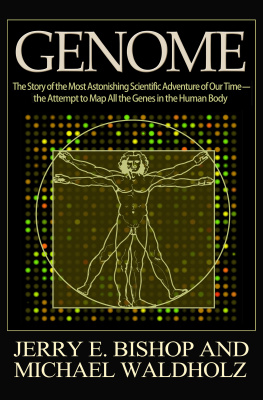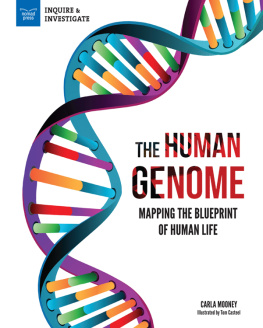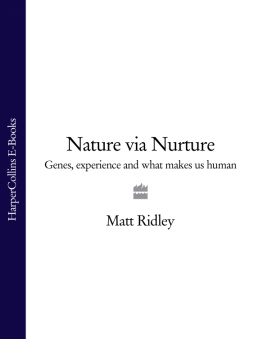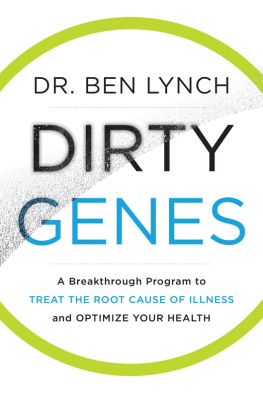The Story of the Most Astonishing Scientific Adventure of Our TimeThe Attempt to Map All the Genes in the Human Body
Jerry E. Bishop and Michael Waldholz
All rights reserved, including without limitation the right to reproduce this ebook or any portion thereof in any form or by any means, whether electronic or mechanical, now known or hereinafter invented, without the express written permission of the publisher.
Copyright 1990 by Jerry E. Bishop and Michael Waldholz
This edition published in 2014 by Open Road Integrated Media, Inc.
To the lasting memory of Jerry E. Bishop
ACKNOWLEDGMENTS
GENOME was published a generation ago in 1990, before most anyone could pronounce its name. Even so, Jerry Bishop and I uncovered the word, and the idea for GENOME, a full five years earlier as a result of an unspoken contest between master and student.
Jerry, who passed away much too soon in 2007, was at the time the Wall Street Journals reigning science writer; I was his disciple.
We could not have possibly imagined then that events we separately uncovered and competed to get onto the pages of the Journal, represented the first details of an emerging technology that has since transformed the understanding of human biology.
Back then, Jerry had written about most every groundbreaking advance in medicine, biology, physics, and astronomy since the late 1950s. At a time when a more innocent and optimistic America was in thrall of the promise of technology, Jerrys front-page Journal stories delighted readers. Though the newspapers audience expected little more with their morning coffee than the latest business news, Jerrys stories enchanted them with behind-the-scenes tales of the scientists who were reshaping the modern world.
He covered the space shots, the conquering of polio, the thalidomide tragedies, breakthroughs in treating heart attacks, the birth of biotechnology, the creation of solar energy, and, well, you get the point. Most importantly, he knew how to tell a story, helping to pioneer a narrative style that has become a model for todays science journalism. Beginning in 1980 when I joined the Journal as a former high school English teacher, Jerry tutored me in an art he was perfecting.
Like all good newsmen, Jerry hated being beaten to a good story, even by me. So it was one day in 1985 when I excitedly told him about an idea I had come across. I had met a biologist who was trying to identify the genes that makes some people susceptible to diseases and other people less so, something that sounded pretty incredible.
Jerry rarely told me what I should or shouldnt do, but as I described the story I wanted to write, I could see that something was amiss. Well, I recall him saying in his quiet Texas drawl, that sounds like something I was thinking about. What he really meant was, Scram, kid, youre on my turf .
Turns out, Jerry had already come across some scientists trying to realize a dream envisioned after Watson and Crick identified the structure of DNA in 1953. Jerry had learned that a group of biologists were laying the groundwork to map the unexplored landscape of the human genome, in essence beginning the same pursuit as my source.
By employing new laboratory techniques, several research teams had been sifting through the DNA of families haunted with a high incidence of certain diseases. One group, led by a young research psychologist named Nancy Wexler (whose gene hunt among villagers in South America opens the first chapter of GENOME) had just pinpointed the location within human DNAs three billion chemical units of the inherited mutation that causes Huntingtons disease, a deadly neurological illness that strikes victims in middle age.
The discovery, announced in 1984, had galvanized labs around the world to conduct their own gene sleuthing expeditions. Some, like the researcher I had encountered, were searching for the genetic malfunctions driving more common ailments such as breast cancer and depression. Unlocking an individuals medical fate, it appeared to us, was engaging the worlds top biologists in a venture that had gotten
This, Jerry and I agreed, was news worthy of front-page attention. Because each of us was concerned that the Journal would take only one story about this unfamiliar science, Jerry cleverly sold our editors on a series of stories. The five-part collection, published in the Wall Street Journal in 1986, won us several awards. In the afterglow, I persuaded Jerry to tackle our stories in a book.
Twenty-two years ago, the discovery of a single gene was big news. But scientists guessed that each human cell contained perhaps 100,000 genes (the number turned out to be only about 30,000). One way to get at them, it was argued, was to lay out the exact sequence of the three billion units of the four chemical nucleotides (identified by the letters A,T,C and G) that make up human DNA. The effort, officially undertaken soon after our book was published, was called The Human Genome Project.
Inaugurated in 1991, the project was completed 10 years later. While that first genome cost almost $1 billion to decipher, individuals can now get their own personal genome sequenced for less than $10,000, with that price expected to drop to $1,000 or less in a few years. By 2010 only about 30 individuals genome been sequenced. In 2011, the number jumped to more than 20,000. Using these maps, doctors can tell people if their genetics put them at risk for more than 2,000 genetically based ailments, including Alzheimers disease and some cancers.
There is little space here to describe all that has occurred since GENOME was published, only a tiny bit of which Jerry and I could hint at or guess. We did, for example, accurately predict that parents in danger of passing an inherited disease to their children would use in vitro fertilization to detect which of their embryos contain a dangerous gene and which did not. And we foresaw the ethical battle that would ensue before the practice gained acceptance.
In fact, GENOME spends a good deal of space discussing the potential for insurers to deny coverage to those whose genetics predisposed them to certain diseases. Perhaps because of our book and others that followed, legislation eventually was passed that protects a persons genetic privacy.
Suffice it to say, though, that the brassiest predictions made by researchers in 2001, when the first genome was decoded, have not been realized. Cures for diabetes, metastatic cancers, and Alzheimers disease are likely still decades away. And gene hunts for diseases we describe in the book, such as the one for Huntingtons, have not led to new treatments.
Yet it is folly to ignore what has come to pass. Scientists have used sequencing technologies to identify genes that make a normal cell become cancerous. Using this knowledge, scientists have created drugs that can extend life for months and years. Though only a few of these drugs have led to outright remissions, their global sales now top more than $20 billion a year.
Scientists have sequenced the genomes of chimpanzees, mice, rats, fruit flies, chickens, dogs, honeybees, sloths, squirrels, and horses, to name a few of the non-human genome projects. The resulting knowledge already is helping find genes to make hardier crops, new medical treatments, and illuminate evolution.











